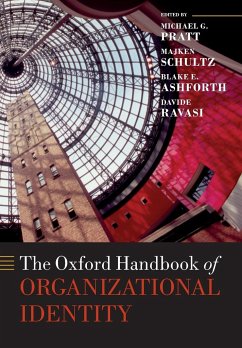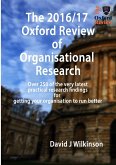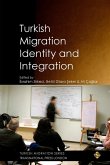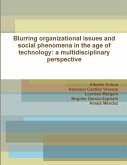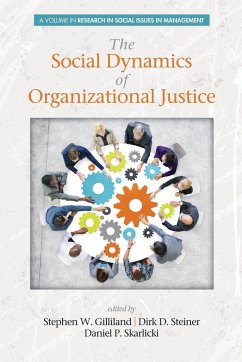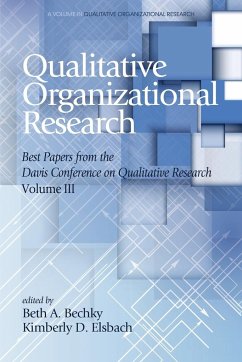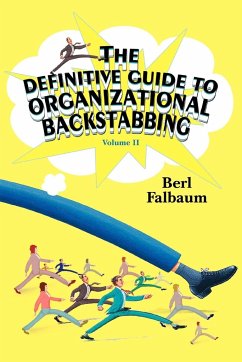The Oxford Handbook of Organizational Identity
Herausgeber: Pratt, Michael G.; Ashforth, Blake E.; Schultz, Majken
The Oxford Handbook of Organizational Identity
Herausgeber: Pratt, Michael G.; Ashforth, Blake E.; Schultz, Majken
- Broschiertes Buch
- Merkliste
- Auf die Merkliste
- Bewerten Bewerten
- Teilen
- Produkt teilen
- Produkterinnerung
- Produkterinnerung
Identity studies focus on how organizations define themselves and what they stand for in relation to internal and external stakeholders. This Handbook offers an introduction to the growing field of organizational identity and a broad range of the most important theories and methods for the study of organizational identity.
Andere Kunden interessierten sich auch für
![The Oxford Review Annual 2016/17 The Oxford Review Annual 2016/17]() David J WilkinsonThe Oxford Review Annual 2016/1727,99 €
David J WilkinsonThe Oxford Review Annual 2016/1727,99 €![Turkish Migration, Identity and Integration Turkish Migration, Identity and Integration]() Ibrahim SirkeciTurkish Migration, Identity and Integration31,99 €
Ibrahim SirkeciTurkish Migration, Identity and Integration31,99 €![Blurring organizational issues and social phenomena in the age of technology Blurring organizational issues and social phenomena in the age of technology]() Nemesio CastilloBlurring organizational issues and social phenomena in the age of technology29,99 €
Nemesio CastilloBlurring organizational issues and social phenomena in the age of technology29,99 €![Institutional and Organizational Transformations in the Robotic Era Institutional and Organizational Transformations in the Robotic Era]() Albena AntonovaInstitutional and Organizational Transformations in the Robotic Era122,99 €
Albena AntonovaInstitutional and Organizational Transformations in the Robotic Era122,99 €![The Social Dynamics of Organizational Justice The Social Dynamics of Organizational Justice]() The Social Dynamics of Organizational Justice59,99 €
The Social Dynamics of Organizational Justice59,99 €![Qualitative Organizational Research Best Papers From the Davis Conference on Qualitative Research, Volume 3 Qualitative Organizational Research Best Papers From the Davis Conference on Qualitative Research, Volume 3]() Qualitative Organizational Research Best Papers From the Davis Conference on Qualitative Research, Volume 360,99 €
Qualitative Organizational Research Best Papers From the Davis Conference on Qualitative Research, Volume 360,99 €![The Definitive Guide to Organizational Backstabbing The Definitive Guide to Organizational Backstabbing]() Berl FalbaumThe Definitive Guide to Organizational Backstabbing13,99 €
Berl FalbaumThe Definitive Guide to Organizational Backstabbing13,99 €-
-
-
Identity studies focus on how organizations define themselves and what they stand for in relation to internal and external stakeholders. This Handbook offers an introduction to the growing field of organizational identity and a broad range of the most important theories and methods for the study of organizational identity.
Hinweis: Dieser Artikel kann nur an eine deutsche Lieferadresse ausgeliefert werden.
Hinweis: Dieser Artikel kann nur an eine deutsche Lieferadresse ausgeliefert werden.
Produktdetails
- Produktdetails
- Verlag: OUP Oxford
- Seitenzahl: 530
- Erscheinungstermin: 10. Mai 2018
- Englisch
- Abmessung: 244mm x 170mm x 28mm
- Gewicht: 904g
- ISBN-13: 9780198815747
- ISBN-10: 0198815743
- Artikelnr.: 49206981
- Herstellerkennzeichnung
- Libri GmbH
- Europaallee 1
- 36244 Bad Hersfeld
- gpsr@libri.de
- Verlag: OUP Oxford
- Seitenzahl: 530
- Erscheinungstermin: 10. Mai 2018
- Englisch
- Abmessung: 244mm x 170mm x 28mm
- Gewicht: 904g
- ISBN-13: 9780198815747
- ISBN-10: 0198815743
- Artikelnr.: 49206981
- Herstellerkennzeichnung
- Libri GmbH
- Europaallee 1
- 36244 Bad Hersfeld
- gpsr@libri.de
Michael G. Pratt is the O'Connor Family Professor in the Carroll School of Management at Boston College. He earned his Ph.D. from the University of Michigan. His research is problem-centered and process-oriented, and consequently he tends to engage in cross-level research. His interests include how individuals connect with the work that they do, as well as to the organizations, professions, occupations, and other collectives in which they find themselves. Theoretically, his research draws heavily from theories of identity and identification, ambivalence, meaning, intuition, and culture (e.g., artifacts). Mike is currently a fellow of the Academy of Management and an associate editor for the Administrative Science Quarterly. Majken Schultz is Professor of Organization and Management since 1996 at Copenhagen Business School. Her research focuses on the interrelations between organizational culture and organizational identity during transformational change. Currently she is interested in how organizations reconstruct their identity in time based on longitudinal studies of LEGO and Carlsberg Group. She has published more than 50 articles in international peer reviewed journals on these topics and edited/co-authored multiple books, including several with Oxford University Press. She is International Research Fellow at the Centre for Corporate Reputation at Oxford University, member of the Royal Danish Academy of Sciences and Letters and serves on several company boards. Blake Ashforth is the Horace Steele Arizona Heritage Chair in the W. P. Carey School of Business, Arizona State University. He received his Ph.D. from the University of Toronto. His research concerns the ongoing dance between individuals and organizations, including identity and identification, socialization and newcomer work adjustment, and the links among individual-, group-, and organization-level phenomena. Recent research has focused on dirty work, ambivalence, and respect. Blake is a fellow of the Academy of Management. Davide Ravasi is Professor of Strategic and Entrepreneurial Management at the Cass Business School, City University London. His research examines interrelations between organizational identity, culture, and strategy in times of change, and how discursive and material artifacts influence sensemaking. He is interested more generally in cultural processes influencing how new objects and new practices come to be, and whether and how they are adopted by individuals and organizations. His works have appeared on the Academy of Management Journal, Organization Science, Journal of Management Studies, Strategic Organization, and other journals.
* Organizational Identity: Mapping Where We Have Been, Where We Are,
and Where We Might Go
* Section 1: Mapping the organizational identity (OI) field
* 1: Peter Foreman and David Whetten: Great debates in organizational
identity study
* 2: Dennis A. Gioia and Aimee L. Hamilton: Measuring organizational
identity: Taking Stock and Looking Forward
* 3: Davide Ravasi: Organizational Identity, Culture and Image
* 4: Blake Ashforth: Cross-Level OI
* 5: Majken Schultz: Identity Change and Temporality
* 6: Michael G. Pratt: Multiple OI and Hybrids
* Section 2: Critical Perspectives on OI
* 7: Tony J Watson: Organizational Identity and Organizational Identity
Work as Valuable Analytical Resources
* 8: Kate Kenney, Andrea Whittle, and Hugh Willmott: Organizational
Identity: The Significance of Power and Politics
* 9: Mats Alvesson and Maxine Robertson: Organizational Identity: A
Critique
* Section 3: Integrative Models of OI
* 10: Ezra Zuckerman: Optimal Distinctiveness Revisited: An Integrative
Framework for Understanding the Balance between Differentiation and
Conformity in Individual and Organizational Identities
* 11: Joep Cornelissen, Mirjam Werner, and Alex Haslam,: Bridging and
Integrating Theories on Organizational Identity: A Social
Interactionist Model of Organizational Identity Formation and Change
* Section 4: How Individuals Relate to OI
* 12: Beth Schinoff, Kristie Rogers, and Kevin G. Corley: How Do We
Communicate Who We Are? Examining How Organizational Identity Is
Conveyed to Members
* 13: Jennifer Petriglieri and Devine: Mobilizing Organizational Action
Against Identity Threats: The Role of Organizational Members'
Perceptions and Responses
* 14: Kimberly Elsbach and Janet Dukerich: Organizational Identity and
the Undesired Self
* Section 5: Sources and processes of OI
* 15: Glen E. Kreiner and Chad Murphy: Organizational Identity Work
* 16: Roy Suddaby, William Foster, and Quinn Trank: ReMembering:
Rhetorical History as Identity-Work
* 17: Lee Watkiss and Mary Ann Glynn: Materiality and Identity: How
Organizational Products, Artifacts, and Practices Instantiate
Organizational Identity
* 18: Daan Van Knippenberg: Making Sense of Who We Are: Leadership and
Organizational Identity
* Section 6: OI and the Environment
* 19: Nelson Philips, Mattew Kraatz, Paul Tracey: Organizational
Identity and Institutions
* 20: Rich Dejordy and W. E. Douglas Creed: Institutional Pluralism,
Inhabitants, and the Construction of Organizational and Personal
Identities
* 21: Marya L. Besharov and Shelley L. Brickson: Organizational
Identity and Institutional Forces: Toward an Integrative Framework
* Section 7: Implications of OI
* 22: Callen Anthony and Mary Tripsas: Organizational Identity and
Innovation
* 23: Mamta Bhatt, Cees B. M. van Riel, and Marijke Baumann: Planned
Organizational Identity Change: Insights from Practice
* 24: Janne Tienari and Eero Vaara: Identity Construction in Mergers
and Acquisitions: A Discursive Sensemaking Perspective
* 25: Caroline Bartel, Cindi Baldi, and Janet Dukerich: Fostering
Stakeholder Identification Through Expressed Organizational
Identities
* 26: Michael G. Pratt, Majken Schultz, Blake Ashforth, and Davide
Ravasi: On the Identity of Organizational Identity: Looking Backwards
Towards the Future
and Where We Might Go
* Section 1: Mapping the organizational identity (OI) field
* 1: Peter Foreman and David Whetten: Great debates in organizational
identity study
* 2: Dennis A. Gioia and Aimee L. Hamilton: Measuring organizational
identity: Taking Stock and Looking Forward
* 3: Davide Ravasi: Organizational Identity, Culture and Image
* 4: Blake Ashforth: Cross-Level OI
* 5: Majken Schultz: Identity Change and Temporality
* 6: Michael G. Pratt: Multiple OI and Hybrids
* Section 2: Critical Perspectives on OI
* 7: Tony J Watson: Organizational Identity and Organizational Identity
Work as Valuable Analytical Resources
* 8: Kate Kenney, Andrea Whittle, and Hugh Willmott: Organizational
Identity: The Significance of Power and Politics
* 9: Mats Alvesson and Maxine Robertson: Organizational Identity: A
Critique
* Section 3: Integrative Models of OI
* 10: Ezra Zuckerman: Optimal Distinctiveness Revisited: An Integrative
Framework for Understanding the Balance between Differentiation and
Conformity in Individual and Organizational Identities
* 11: Joep Cornelissen, Mirjam Werner, and Alex Haslam,: Bridging and
Integrating Theories on Organizational Identity: A Social
Interactionist Model of Organizational Identity Formation and Change
* Section 4: How Individuals Relate to OI
* 12: Beth Schinoff, Kristie Rogers, and Kevin G. Corley: How Do We
Communicate Who We Are? Examining How Organizational Identity Is
Conveyed to Members
* 13: Jennifer Petriglieri and Devine: Mobilizing Organizational Action
Against Identity Threats: The Role of Organizational Members'
Perceptions and Responses
* 14: Kimberly Elsbach and Janet Dukerich: Organizational Identity and
the Undesired Self
* Section 5: Sources and processes of OI
* 15: Glen E. Kreiner and Chad Murphy: Organizational Identity Work
* 16: Roy Suddaby, William Foster, and Quinn Trank: ReMembering:
Rhetorical History as Identity-Work
* 17: Lee Watkiss and Mary Ann Glynn: Materiality and Identity: How
Organizational Products, Artifacts, and Practices Instantiate
Organizational Identity
* 18: Daan Van Knippenberg: Making Sense of Who We Are: Leadership and
Organizational Identity
* Section 6: OI and the Environment
* 19: Nelson Philips, Mattew Kraatz, Paul Tracey: Organizational
Identity and Institutions
* 20: Rich Dejordy and W. E. Douglas Creed: Institutional Pluralism,
Inhabitants, and the Construction of Organizational and Personal
Identities
* 21: Marya L. Besharov and Shelley L. Brickson: Organizational
Identity and Institutional Forces: Toward an Integrative Framework
* Section 7: Implications of OI
* 22: Callen Anthony and Mary Tripsas: Organizational Identity and
Innovation
* 23: Mamta Bhatt, Cees B. M. van Riel, and Marijke Baumann: Planned
Organizational Identity Change: Insights from Practice
* 24: Janne Tienari and Eero Vaara: Identity Construction in Mergers
and Acquisitions: A Discursive Sensemaking Perspective
* 25: Caroline Bartel, Cindi Baldi, and Janet Dukerich: Fostering
Stakeholder Identification Through Expressed Organizational
Identities
* 26: Michael G. Pratt, Majken Schultz, Blake Ashforth, and Davide
Ravasi: On the Identity of Organizational Identity: Looking Backwards
Towards the Future
* Organizational Identity: Mapping Where We Have Been, Where We Are,
and Where We Might Go
* Section 1: Mapping the organizational identity (OI) field
* 1: Peter Foreman and David Whetten: Great debates in organizational
identity study
* 2: Dennis A. Gioia and Aimee L. Hamilton: Measuring organizational
identity: Taking Stock and Looking Forward
* 3: Davide Ravasi: Organizational Identity, Culture and Image
* 4: Blake Ashforth: Cross-Level OI
* 5: Majken Schultz: Identity Change and Temporality
* 6: Michael G. Pratt: Multiple OI and Hybrids
* Section 2: Critical Perspectives on OI
* 7: Tony J Watson: Organizational Identity and Organizational Identity
Work as Valuable Analytical Resources
* 8: Kate Kenney, Andrea Whittle, and Hugh Willmott: Organizational
Identity: The Significance of Power and Politics
* 9: Mats Alvesson and Maxine Robertson: Organizational Identity: A
Critique
* Section 3: Integrative Models of OI
* 10: Ezra Zuckerman: Optimal Distinctiveness Revisited: An Integrative
Framework for Understanding the Balance between Differentiation and
Conformity in Individual and Organizational Identities
* 11: Joep Cornelissen, Mirjam Werner, and Alex Haslam,: Bridging and
Integrating Theories on Organizational Identity: A Social
Interactionist Model of Organizational Identity Formation and Change
* Section 4: How Individuals Relate to OI
* 12: Beth Schinoff, Kristie Rogers, and Kevin G. Corley: How Do We
Communicate Who We Are? Examining How Organizational Identity Is
Conveyed to Members
* 13: Jennifer Petriglieri and Devine: Mobilizing Organizational Action
Against Identity Threats: The Role of Organizational Members'
Perceptions and Responses
* 14: Kimberly Elsbach and Janet Dukerich: Organizational Identity and
the Undesired Self
* Section 5: Sources and processes of OI
* 15: Glen E. Kreiner and Chad Murphy: Organizational Identity Work
* 16: Roy Suddaby, William Foster, and Quinn Trank: ReMembering:
Rhetorical History as Identity-Work
* 17: Lee Watkiss and Mary Ann Glynn: Materiality and Identity: How
Organizational Products, Artifacts, and Practices Instantiate
Organizational Identity
* 18: Daan Van Knippenberg: Making Sense of Who We Are: Leadership and
Organizational Identity
* Section 6: OI and the Environment
* 19: Nelson Philips, Mattew Kraatz, Paul Tracey: Organizational
Identity and Institutions
* 20: Rich Dejordy and W. E. Douglas Creed: Institutional Pluralism,
Inhabitants, and the Construction of Organizational and Personal
Identities
* 21: Marya L. Besharov and Shelley L. Brickson: Organizational
Identity and Institutional Forces: Toward an Integrative Framework
* Section 7: Implications of OI
* 22: Callen Anthony and Mary Tripsas: Organizational Identity and
Innovation
* 23: Mamta Bhatt, Cees B. M. van Riel, and Marijke Baumann: Planned
Organizational Identity Change: Insights from Practice
* 24: Janne Tienari and Eero Vaara: Identity Construction in Mergers
and Acquisitions: A Discursive Sensemaking Perspective
* 25: Caroline Bartel, Cindi Baldi, and Janet Dukerich: Fostering
Stakeholder Identification Through Expressed Organizational
Identities
* 26: Michael G. Pratt, Majken Schultz, Blake Ashforth, and Davide
Ravasi: On the Identity of Organizational Identity: Looking Backwards
Towards the Future
and Where We Might Go
* Section 1: Mapping the organizational identity (OI) field
* 1: Peter Foreman and David Whetten: Great debates in organizational
identity study
* 2: Dennis A. Gioia and Aimee L. Hamilton: Measuring organizational
identity: Taking Stock and Looking Forward
* 3: Davide Ravasi: Organizational Identity, Culture and Image
* 4: Blake Ashforth: Cross-Level OI
* 5: Majken Schultz: Identity Change and Temporality
* 6: Michael G. Pratt: Multiple OI and Hybrids
* Section 2: Critical Perspectives on OI
* 7: Tony J Watson: Organizational Identity and Organizational Identity
Work as Valuable Analytical Resources
* 8: Kate Kenney, Andrea Whittle, and Hugh Willmott: Organizational
Identity: The Significance of Power and Politics
* 9: Mats Alvesson and Maxine Robertson: Organizational Identity: A
Critique
* Section 3: Integrative Models of OI
* 10: Ezra Zuckerman: Optimal Distinctiveness Revisited: An Integrative
Framework for Understanding the Balance between Differentiation and
Conformity in Individual and Organizational Identities
* 11: Joep Cornelissen, Mirjam Werner, and Alex Haslam,: Bridging and
Integrating Theories on Organizational Identity: A Social
Interactionist Model of Organizational Identity Formation and Change
* Section 4: How Individuals Relate to OI
* 12: Beth Schinoff, Kristie Rogers, and Kevin G. Corley: How Do We
Communicate Who We Are? Examining How Organizational Identity Is
Conveyed to Members
* 13: Jennifer Petriglieri and Devine: Mobilizing Organizational Action
Against Identity Threats: The Role of Organizational Members'
Perceptions and Responses
* 14: Kimberly Elsbach and Janet Dukerich: Organizational Identity and
the Undesired Self
* Section 5: Sources and processes of OI
* 15: Glen E. Kreiner and Chad Murphy: Organizational Identity Work
* 16: Roy Suddaby, William Foster, and Quinn Trank: ReMembering:
Rhetorical History as Identity-Work
* 17: Lee Watkiss and Mary Ann Glynn: Materiality and Identity: How
Organizational Products, Artifacts, and Practices Instantiate
Organizational Identity
* 18: Daan Van Knippenberg: Making Sense of Who We Are: Leadership and
Organizational Identity
* Section 6: OI and the Environment
* 19: Nelson Philips, Mattew Kraatz, Paul Tracey: Organizational
Identity and Institutions
* 20: Rich Dejordy and W. E. Douglas Creed: Institutional Pluralism,
Inhabitants, and the Construction of Organizational and Personal
Identities
* 21: Marya L. Besharov and Shelley L. Brickson: Organizational
Identity and Institutional Forces: Toward an Integrative Framework
* Section 7: Implications of OI
* 22: Callen Anthony and Mary Tripsas: Organizational Identity and
Innovation
* 23: Mamta Bhatt, Cees B. M. van Riel, and Marijke Baumann: Planned
Organizational Identity Change: Insights from Practice
* 24: Janne Tienari and Eero Vaara: Identity Construction in Mergers
and Acquisitions: A Discursive Sensemaking Perspective
* 25: Caroline Bartel, Cindi Baldi, and Janet Dukerich: Fostering
Stakeholder Identification Through Expressed Organizational
Identities
* 26: Michael G. Pratt, Majken Schultz, Blake Ashforth, and Davide
Ravasi: On the Identity of Organizational Identity: Looking Backwards
Towards the Future

